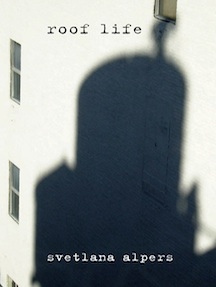By Corey Wronski-Mayersak
Roof Life is a book to think with and see with, and most of all, a companion volume to the practice of reflective living. Lyrical and meditative, Roof Life is nonetheless a provocation in the best sense, challenging readers to see the everyday world deeply, questioningly, and with surprise and wonder.
Svetlana Alpers, best known as an art historian, brings a scholar’s analytical acumen and her own philosophical mode of being to an exploration of the many contexts of seeing. Through a series of meditations on situations as diverse as family history, urban landscapes, posing for portraits, and the fresh food markets of France, Alpers invites the reader into the perspectives from which she sees. In the process, she prompts us to rethink the perspectives from which we see. Roof Life’s diverse meditations are linked by close attention to setting—to the shape and experience of places—and the theme of viewing from a distance.
Alpers’s first chapter traces the history of her paternal family. An inquiry into the birth of her father (Nobel Prize winning economist Wassily Leontief) opens into an exploration of the lives of her grandparents in the volatile world of early twentieth-century Russia and Germany. The goal here is not simply to archive her grandparents’ story, but to consider the settings and circles in which they spent their lives, the paradoxes of their being both within and removed from events of their historical context, and what it means to see all of this from Alpers’s perspective years later.
The book then turns to physical sight. Chapter two captures the experience of living at the top of New York, with Alpers contemplating the views and events (construction, water towers, shadows, 9/11) seen through her loft windows. Chapter three examines what it means to see objects in one’s daily life as art. Many of Alpers’s reflections here involve the transfer of objects—acquisition and sale—and its impact on how one sees them. She shares a personal story of the emotions and altered views produced by inheriting and selling a painting, and also explores the experience of seeing one’s house and other personal effects as art. Again, the connecting theme is distance. As Alpers puts it, what provokes seeing something as art is “a matter of distance, an appearance of being strange,” as opposed to the familiar. The final chapter develops the idea of seeing oneself, recognizing and misrecognizing oneself in shadows, photos, and drawings.
A digression to the topic of food in chapter four eases the intensity of the other reflections. Still thought-provoking but lighter in tone, here Alpers recalls her varied experiences cooking in different environments. Yet the focus is not on cooking itself, but on the experience of looking at food and its diverse settings: the aesthetics of ingredients, their collection, and their assembly. We follow Alpers to observe cultural differences of purchasing food around the world, the atmosphere of academic dinner parties, the visual tableau of restaurant meals, and the social aspects of entertaining, dining out, and shopping. Bibliophiles, not just cooks, will enjoy Alpers’s musings on the role of cookbooks, which inspire reflection on how new media (such as the online recipe) alters the embodiedness of our cooking traditions.
Roof Life is intensely personal, not only because Alpers brings the reader into intimate scenes of her life, but because we are invited to see in and from her position. The personal element charmingly informs even her list of sources and texts, which references books “available to hand on my bookshelves,” and Alpers frequently quotes from her own informal notes. Such moves draw us further into the author’s private world. Yet Alpers emphasizes that the book is not a memoir. It is also neither pure critical theory nor art history.
The book resists a firm label or category, and in so doing, it mirrors another of its themes: the tension between the verbal and visual. This concern recurs throughout the book as Alpers grapples with how to put views into words, frequently comparing her writing to painting and to filling a canvas.
Ultimately, Roof Life is best described as a thinking book. And just as Alpers takes us pensively and lyrically through the settings she describes, it is a book best experienced by allowing oneself to flow in and out of its scenes without pressure to read systematically. The spirit of Roof Life is more recursive than linear. In a fitting analogy, Alpers beautifully compares its starting point to “waves spreading out from the point where a pebble strikes the surface of a pool.” It requires and rewards a reader willing to be open to its creative endeavor. To read, or to view, the book from only one angle would be to work against and diminish its project of calling attention to the complexity of sight.
Corey Wronski-Mayersak (ΦBK, Goucher College, 2002) is an Assistant Professor of English at McDaniel College and a resident member of the Delta of Maryland chapter of Phi Beta Kappa.




